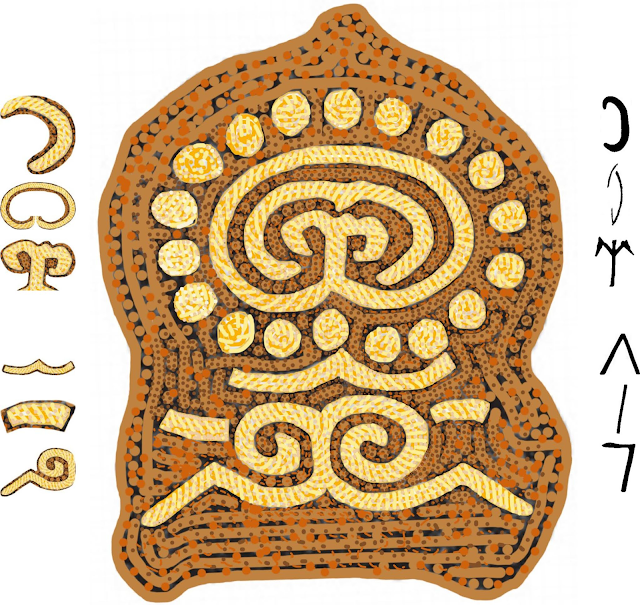Mestec Kralové avar szíjvége a szimmetrikus "Nagyon nagy Lyukó úr" mondattal
Nada Profantova published in her study titled Bronzefunde des 7. Jahrhunderts aus Méstec Králové (Bez. Nymburk, Böhmen (1) the description and drawings of the pieces of a treasure find unearthed in Middle-Bohemia. On two of these finds there are readable signs. These are the hieroglyphic signs of the Hungarian rune alphabets. I published earlier an article about the fragment with the eagle heads. In this current article I am going to analyze the other object: the beltend fitting with rune letters (Figure 1).
The shape of the beltend is very typical. The arch over the horizontal platform supported with a vertical line in the middle reveals itself at first reading as the frontal view of a Cosmos-model. This is an example of the depiction convention of the „sky-supporting tree”. (1)
The drawing consists of readable hieroglyphs. The arch of the firmament is created of two nagy "great, big" hieroglyphics signs (2). In the middle, the ligature readable as God/divinity Lyuko symbolizes the sky-supporting tree that is identical with the God (i.e. with the Milky Way). This ligature can be seen on several Hun vats, too (Fig. 2 & 3). The complete meaning of the symmetric sign-complex on the Avarian beltend from Mestec Kralové is “Lyuko the Great/Glorious God/divinity”.
Fig. 2) The sentence Lyukó szár „Lyuko the God/divinity” on the Hun vat of Rádpuszta (Kaposvölgy) readable from the top to the down (in the middle), the hieroglyphs szár „God, divinity, Lord” and Lyukó „Lyuko” from Rádpuszta (on the left side, readable from the top to the down) as well as the Szekler runes "sz" & "ly" with hieroglyphic meaning (on the right side).
Fig. 3) The ligature Lyukó szár „Lyuko the God/divinity” on the Hun vat of Kaposvölgy (foto by Ádám Vágó) can be read from the perspective of the God, i.e. upside-down for the humans.
The ligature inscription nagy szár „Great/Glorious divinity/God” on the cauldron ears of the Hun vat of Rádpuszta (Kaposvölgy) can be read from human perspective (Fig 4). This double bustrophedon-like writing is a typical Eastern feature of the millennia before Christi (see f.e. the Trialet-culture and China).
Fig. 4) The ligature nagy szár „Great/Glorious divinity/God” on the Hun vat of Kaposvölgy stands on its feet and can be read from the top to the down (on the top the hieroglyph nagy “Great, Glorious”, below that the hieroglyph szár „divinity, God, Lord”).
Fig. 5) One part of a Hun jewellery from Kerch with the text nagyon nagy „Very Great” on its top.
Fig. 6) The sentence „Territory of the great God” (in the middle) on the Avarian rosette from Kölkedi (on the left side): the „n” letter of the Szekler alphabet (on the top of the right side) is already vertical.
Fig. 7) A beltend from the Avarian graveyard of Zamárdi (in the middle) with the sentence nagyon nagy Óg ten „Very great Og Ten” (Ten = God, in modern Hungarian Is-Ten), on the left side from the top to down the hieroglyphs nagy „Great, Glorious”, Óg „Og” and Ten „Ten”, the apt Szekler rune letters "n", "o/ó" and „ten” on the right side.
On the beltend from Zamárdi and on the beltend of Mestec Kralové the texts are placed very similarly (Fig. 7).
Footnotes
(1) To the Cosmos-models see the book A magyarság jelképei, to the depiction conventions see the book titled Magyar hieroglif írás !
(2) The arch of the firmament in the Hun and Avar hieroglyphic texts is often identical with the hieroglyph of „Great” that initially had been horizontal (Fig 4 & 5) but later became vertical (because of the changing writing technology of the rune scripts, see Fig. 1 & 7). This Avarian text from Bohemia contains already two vertical „Great” hieroglyphs (Fig. 1). In contrast to that, on the Hun vat of Kaposvölgyi (Fig. 3 & 4), on the Hun jewellery of Kerch (Fig 5) and on the Avarian rosette of Kölked (Fig. 6) the horizontal version of this hieroglyph can be seen.
Literature
Varga, Géza: Magyar hieroglif írás, Írástörténeti Kutatóintézet/ Institute of Writing History, Budapest, 2017.
Varga, Géza: A magyarság jelképei, Írástörténeti Kutatóintézet/ Institute of Writing History, Budapest, 1999.
Varga, Géza: Olvasható avar turulok Közép-Csehországból
Varga, Géza: Avarian Turul-birds from Middle-Bohemia that can be interpreted and read as texts
Varga, Géza: A Masek Zsófia által leírt ócsai hun üst-töredék olvasata
Varga, Géza: A talpukon, vagy a fejük tetején álló jelek kérdése
Varga, Géza: Hun és avar tartalom
[1] The Turul – in Turkish (Er)-Tugrul – was the falcon-like mythological holy bird of early Hungarians and other Scythian people - the Translator.
[2] Nowadays, an intensive debate is running around the Hungarian Holy Crown or Stephan’s Crown. According to the historical tradition, the Crown had been sent by Pope Sylvester II to Prince Vajk who was crowned to the first Hungarian king in 1000 AD. Some modern historians state that the Crown was manufactured later, in the time of King Béla III (1148 – 1196). In contrast to that, a group of historians and art historians assert the Crown was created much earlier, presumably in the time of Scythians or Huns. See the short summary: https://en.wikipedia.org/wiki/Holy_Crown_of_Hungary - the Translator








Nincsenek megjegyzések:
Megjegyzés küldése